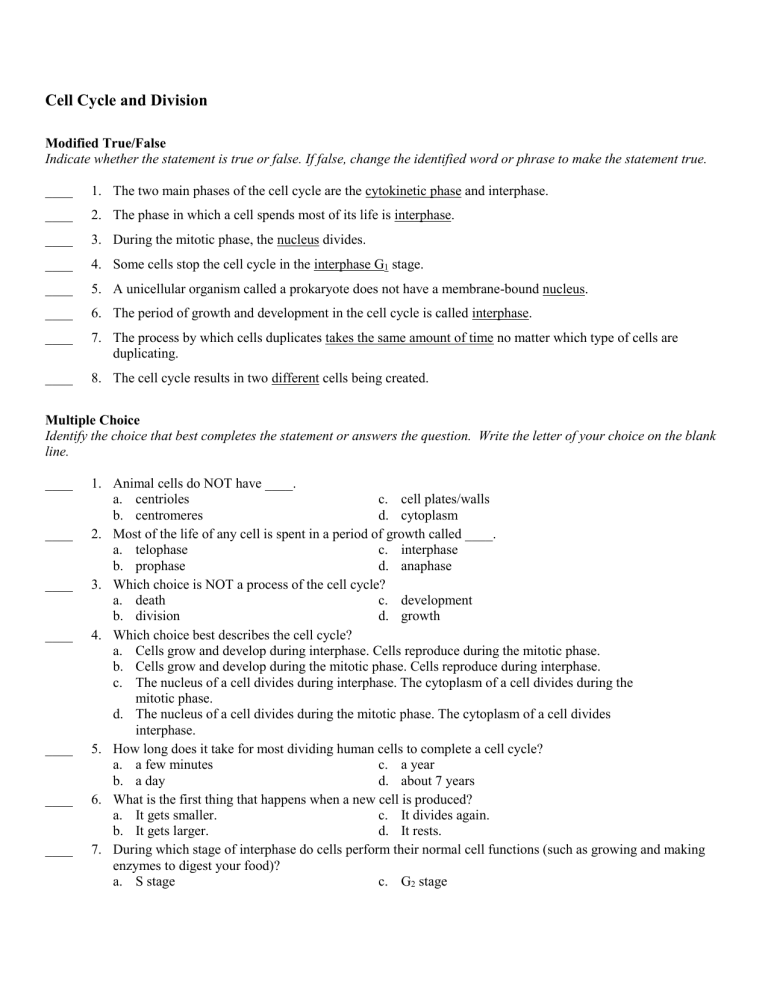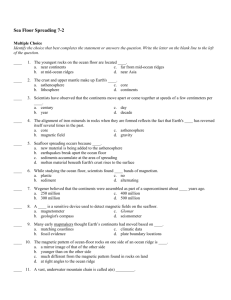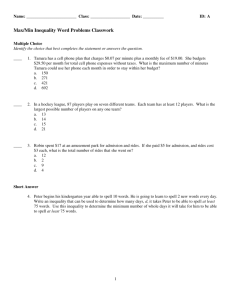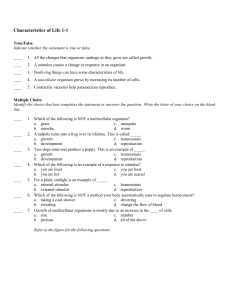
Cell Cycle and Division Modified True/False Indicate whether the statement is true or false. If false, change the identified word or phrase to make the statement true. ____ 1. The two main phases of the cell cycle are the cytokinetic phase and interphase. ____ 2. The phase in which a cell spends most of its life is interphase. ____ 3. During the mitotic phase, the nucleus divides. ____ 4. Some cells stop the cell cycle in the interphase G1 stage. ____ 5. A unicellular organism called a prokaryote does not have a membrane-bound nucleus. ____ 6. The period of growth and development in the cell cycle is called interphase. ____ 7. The process by which cells duplicates takes the same amount of time no matter which type of cells are duplicating. ____ 8. The cell cycle results in two different cells being created. Multiple Choice Identify the choice that best completes the statement or answers the question. Write the letter of your choice on the blank line. ____ ____ ____ ____ ____ ____ ____ 1. Animal cells do NOT have ____. a. centrioles c. cell plates/walls b. centromeres d. cytoplasm 2. Most of the life of any cell is spent in a period of growth called ____. a. telophase c. interphase b. prophase d. anaphase 3. Which choice is NOT a process of the cell cycle? a. death c. development b. division d. growth 4. Which choice best describes the cell cycle? a. Cells grow and develop during interphase. Cells reproduce during the mitotic phase. b. Cells grow and develop during the mitotic phase. Cells reproduce during interphase. c. The nucleus of a cell divides during interphase. The cytoplasm of a cell divides during the mitotic phase. d. The nucleus of a cell divides during the mitotic phase. The cytoplasm of a cell divides interphase. 5. How long does it take for most dividing human cells to complete a cell cycle? a. a few minutes c. a year b. a day d. about 7 years 6. What is the first thing that happens when a new cell is produced? a. It gets smaller. c. It divides again. b. It gets larger. d. It rests. 7. During which stage of interphase do cells perform their normal cell functions (such as growing and making enzymes to digest your food)? a. S stage c. G2 stage ____ 8. ____ 9. ____ 10. ____ 11. ____ 12. ____ 13. ____ 14. ____ 15. ____ 16. ____ 17. b. G1 stage d. Mitosis During which stage of interphase do cells copy their DNA? a. S stage c. G2 stage b. G1 stage d. Cytokinesis During which stage of interphase do cells store energy in final preparation for use in the mitotic phase? a. G2 c. S b. G3 d. S2 During the S stage of interphase, pairs of identical chromosomes are held together by which structure? a. centromere c. connectroid b. chromatid d. centromatid Identify two stages of the mitotic phase. a. prophase and metaphase b. cytokinesis and interphase c. mitosis and interphase d. interphase and metaphase If a cell has 22 duplicated chromosomes, how many chromatids does it have? a. 22 c. 11 b. 44 d. 88 What is the shortest phase of interphase? a. G2 c. S b. metaphase d. prophase Which type of cell divides by the cell membrane pinching together until the two cells split apart? a. plant c. cytoplastic b. animal d. chromosomal Which best describes how a plant cell divides? a. A new cell plate and wall forms in the middle of the cell and two new cells are formed. b. The two cells twist apart. c. The membrane pinches shut in the middle of the cell and the cells are split apart. d. Plant cells do not divide. Which of the following is NOT a result of cell division? a. reproduction c. growth b. nutrition d. repair How long does it take a cell to complete the cell cycle? a. 8 minutes b. 1 year c. 24 hours d. The time it takes depends on the type of cell that is dividing. Matching Match each phase or stage name with the correct letter from the diagram. ____ ____ ____ ____ ____ ____ ____ 1. 2. 3. 4. 5. 6. 7. mitotic phase interphase G1 G2 mitosis S cytokinesis Match each activity to the correct phase of mitosis. You may use the same answer more than once. a. prophase b. metaphase c. anaphase d. telophase ____ 8. Chromosomes line up single file at the middle of the cell. ____ 9. Two identical nuclei form. ____ 10. Sister chromatids separate. ____ 11. Spindle fibers begin to form and the nuclear membrane begins to break down ____ 12. Spindle fibers break down. Cell Cycle and Division Answer Section MODIFIED TRUE/FALSE 1. ANS: F, mitotic phase 2. 3. 4. 5. 6. 7. PTS: 1 DIF: Bloom's Level 1 | DOK 1-LOW REF: To review this topic refer to From a Cell to an Organism: Lesson 1 OBJ: 3-1 STA: 5.3.8.A.1 | 5.3.8.A.2 ANS: T PTS: 1 DIF: Bloom's Level 1 | DOK 1-LOW REF: To review this topic refer to From a Cell to an Organism: Lesson 1 OBJ: 3-1 STA: 5.3.8.A.2 ANS: T PTS: 1 DIF: Bloom's Level 1 | DOK 1-LOW REF: To review this topic refer to From a Cell to an Organism: Lesson 1 OBJ: 3-1 STA: 5.3.8.A.1 | 5.3.8.A.2 ANS: T PTS: 1 DIF: Bloom's Level 1 | DOK 1-LOW REF: To review this topic refer to From a Cell to an Organism: Lesson 1 OBJ: 3-1 STA: 5.3.8.A.1 | 5.3.8.A.2 ANS: T PTS: 1 DIF: Bloom's Level 1 | DOK 1-LOW REF: To review this topic refer to From a Cell to an Organism: Lesson 2 OBJ: 3-3 STA: 5.3.8.A.1 | 5.3.8.A.2 ANS: T PTS: 1 DIF: Bloom's Level 1 | DOK 1-LOW REF: To review this topic refer to From a Cell to an Organism: Lesson 1 OBJ: 3-1 STA: 5.3.8.A.1 | 5.3.8.A.2 ANS: F Different types of cells duplicate at different rates. PTS: REF: OBJ: 8. ANS: 1 DIF: Bloom's Level 1 | DOK 1-LOW To review this topic refer to From a Cell to an Organism: Lesson 2 3-4 STA: 5.3.8.A.1 | 5.3.8.A.2 F, identical PTS: 1 MULTIPLE CHOICE 1. ANS: C Cytokinesis in plants happens in a different way. A new cell wall forms in the middle of a plant cell. PTS: 1 DIF: Bloom's Level 2 | DOK 1-LOW REF: To review this topic refer to From a Cell to an Organism: Lesson 1 OBJ: 3-1 STA: 5.3.8.A.1 | 5.3.8.A.2 2. ANS: C Interphase is the period during the cell cycle of a cell’s growth and development. PTS: 1 DIF: Bloom's Level 1 | DOK 1-LOW REF: To review this topic refer to From a Cell to an Organism: Lesson 1 OBJ: 3-1 STA: 5.3.8.A.1 | 5.3.8.A.2 3. ANS: A The cell cycle is a continuous cycle. While some cells die, it is not a part of the cell cycle. PTS: 1 DIF: Bloom's Level 1 | DOK 1-LOW REF: To review this topic refer to From a Cell to an Organism: Lesson 1 OBJ: 3-1 STA: 5.3.8.A.1 | 5.3.8.A.2 4. ANS: A The nucleus and cytoplasm both divide during the mitotic phase. PTS: 1 DIF: Bloom's Level 3 | DOK 2-MOD REF: To review this topic refer to From a Cell to an Organism: Lesson 1 OBJ: 3-1 STA: 5.3.8.A.1 | 5.3.8.A.2 5. ANS: B Most dividing human cells normally complete the cell cycle in about 24 hours. PTS: 1 DIF: Bloom's Level 1 | DOK 1-LOW REF: To review this topic refer to From a Cell to an Organism: Lesson 1 OBJ: 3-1 STA: 5.3.8.A.1 | 5.3.8.A.2 6. ANS: B Cells begin the interphase with a period of rapid growth. PTS: 1 DIF: Bloom's Level 2 | DOK 2-MOD REF: To review this topic refer to From a Cell to an Organism: Lesson 1 OBJ: 3-1 STA: 5.3.8.A.1 | 5.3.8.A.2 7. ANS: B During G1, a cell grows and performs its normal function. During S, the cell copies its DNA, during G2, the cell grows and stores energy to use in the mitotic stage. PTS: 1 DIF: Bloom's Level 1 | DOK 1-LOW REF: To review this topic refer to From a Cell to an Organism: Lesson 1 OBJ: 3-1 STA: 5.3.8.A.1 | 5.3.8.A.2 8. ANS: A During G1, a cell grows and performs its normal function. During S, the cell copies its DNA, during G2, the cell grows and stores energy to use in the mitotic stage. PTS: 1 DIF: Bloom's Level 1 | DOK 1-LOW REF: To review this topic refer to From a Cell to an Organism: Lesson 1 OBJ: 3-1 STA: 5.3.6.D.3 | 5.3.8.D.1 | 5.3.8.A.1 | 5.3.8.A.2 9. ANS: A During G1, a cell grows and performs its normal function. During S, the cell copies its DNA, during G2, the cell grows and stores energy to use in the mitotic stage. PTS: 1 DIF: Bloom's Level 1 | DOK 1-LOW REF: To review this topic refer to From a Cell to an Organism: Lesson 1 OBJ: 3-1 STA: 5.3.8.A.1 | 5.3.8.A.2 10. ANS: A Sister chromatids are held together by a centromere. PTS: 1 DIF: Bloom's Level 1 | DOK 1-LOW REF: To review this topic refer to From a Cell to an Organism: Lesson 1 OBJ: 3-1 STA: 5.3.8.A.1 | 5.3.8.A.2 11. ANS: A The mitotic phase includes prophase and metaphase. PTS: 1 DIF: Bloom's Level 1 | DOK 1-LOW REF: To review this topic refer to From a Cell to an Organism: Lesson 1 OBJ: 3-1 STA: 5.3.8.A.1 | 5.3.8.A.2 | 5.3.6.D.3 | 5.3.8.D.1 12. ANS: B The DNA are replicated, making two identical chromatids. PTS: REF: OBJ: 13. ANS: G2 1 DIF: Bloom's Level 3 | DOK 3-MOD To review this topic refer to From a Cell to an Organism: Lesson 1 3-1 STA: 5.3.8.A.1 | 5.3.8.A.2 | 5.3.6.D.3 | 5.3.8.D.1 A PTS: 1 DIF: Bloom's Level 1 | DOK 1-LOW REF: To review this topic refer to From a Cell to an Organism: Lesson 1 OBJ: 3-1 STA: 5.3.8.A.1 | 5.3.8.A.2 | 5.3.6.D.3 | 5.3.8.D.1 14. ANS: B Animal cells divide when the cell membrane squeezes together around the center of the cell. The furrow grows deeper until it comes together and divides the cell. PTS: 1 DIF: Bloom's Level 1 | DOK 1-LOW REF: To review this topic refer to From a Cell to an Organism: Lesson 1 OBJ: 3-1 STA: 5.3.8.A.1 | 5.3.8.A.2 | 5.3.6.D.3 | 5.3.8.D.1 15. ANS: A Cytokinesis occurs in plants by the formation of a new wall in the center of the cell. PTS: 1 DIF: Bloom's Level 2 | DOK 2-MOD REF: To review this topic refer to From a Cell to an Organism: Lesson 1 OBJ: 3-1 STA: 5.3.8.A.1 | 5.3.8.A.2 | 5.3.6.D.3 | 5.3.8.D.1 16. ANS: B The results of cell division are reproduction, growth, replacement, and repair. PTS: 1 DIF: Bloom's Level 1 | DOK 1-LOW REF: To review this topic refer to From a Cell to an Organism: Lesson 1 OBJ: 3-2 STA: 5.3.8.B.1 17. ANS: D Different types of cells require different amounts of time to complete a cell cycle. PTS: 1 DIF: Bloom's Level 2 | DOK 1-LOW REF: To review this topic refer to From a Cell to an Organism: Lesson 1 OBJ: 3-1 STA: 5.3.8.A.2 MATCHING 1. ANS: REF: OBJ: 2. ANS: REF: OBJ: 3. ANS: REF: OBJ: 4. ANS: REF: OBJ: 5. ANS: REF: OBJ: 6. ANS: REF: OBJ: 7. ANS: REF: OBJ: G PTS: 1 DIF: Bloom's Level 1 | DOK 1-LOW To review this topic refer to From a Cell to an Organism: Lesson 1 3-1 STA: 5.3.6.A.2 | 5.3.8.A.1 | 5.3.8.A.2 A PTS: 1 DIF: Bloom's Level 1 | DOK 1-LOW To review this topic refer to From a Cell to an Organism: Lesson 1 3-1 STA: 5.3.6.A.2 | 5.3.8.A.1 | 5.3.8.A.2 C PTS: 1 DIF: Bloom's Level 1 | DOK 1-LOW To review this topic refer to From a Cell to an Organism: Lesson 1 3-1 STA: 5.3.6.A.2 | 5.3.8.A.1 | 5.3.8.A.2 D PTS: 1 DIF: Bloom's Level 1 | DOK 1-LOW To review this topic refer to From a Cell to an Organism: Lesson 1 3-1 STA: 5.3.6.A.2 | 5.3.8.A.1 | 5.3.8.A.2 E PTS: 1 DIF: Bloom's Level 1 | DOK 1-LOW To review this topic refer to From a Cell to an Organism: Lesson 1 3-1 STA: 5.3.6.A.2 | 5.3.8.A.1 | 5.3.8.A.2 B PTS: 1 DIF: Bloom's Level 1 | DOK 1-LOW To review this topic refer to From a Cell to an Organism: Lesson 1 3-1 STA: 5.3.6.A.2 | 5.3.8.A.1 | 5.3.8.A.2 F PTS: 1 DIF: Bloom's Level 1 | DOK 1-LOW To review this topic refer to From a Cell to an Organism: Lesson 1 3-1 STA: 5.3.6.A.2 | 5.3.8.A.1 | 5.3.8.A.2 8. ANS: REF: OBJ: 9. ANS: REF: OBJ: 10. ANS: REF: OBJ: 11. ANS: REF: OBJ: 12. ANS: REF: OBJ: B PTS: 1 DIF: Bloom's Level 2 | DOK 2-MOD To review this topic refer to From a Cell to an Organism: Lesson 1 3-1 STA: 5.3.6.A.2 | 5.3.8.A.1 | 5.3.8.A.2 D PTS: 1 DIF: Bloom's Level 2 | DOK 2-MOD To review this topic refer to From a Cell to an Organism: Lesson 1 3-1 STA: 5.3.6.A.2 | 5.3.8.A.1 | 5.3.8.A.2 C PTS: 1 DIF: Bloom's Level 2 | DOK 2-MOD To review this topic refer to From a Cell to an Organism: Lesson 1 3-1 STA: 5.3.6.A.2 | 5.3.8.A.1 | 5.3.8.A.2 A PTS: 1 DIF: Bloom's Level 2 | DOK 2-MOD To review this topic refer to From a Cell to an Organism: Lesson 1 3-1 STA: 5.3.6.A.2 | 5.3.8.A.1 | 5.3.8.A.2 D PTS: 1 DIF: Bloom's Level 2 | DOK 2-MOD To review this topic refer to From a Cell to an Organism: Lesson 1 3-1 STA: 5.3.6.A.2 | 5.3.8.A.1 | 5.3.8.A.2







